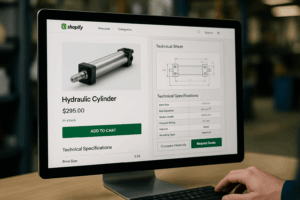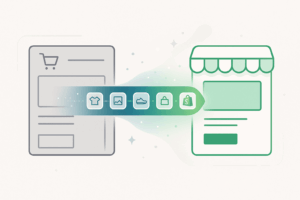When Spec Sheets Are the Real Product
In industrial ecommerce, people don’t buy on emotion. They buy on confidence. And that confidence is built on one thing above all else—documentation.
No matter how slick your ecommerce site looks or how optimized your checkout flow is, if a buyer can’t find the exact material spec, pressure rating, or compliance sheet they need, the sale stalls. Or worse, it goes somewhere else.
For manufacturers running complex catalogs on a legacy ecommerce platform like Miva, the product detail page isn’t just a place to show off SKUs—it’s a trust hub. It’s where spec sheets, installation diagrams, tolerance tables, and certification PDFs converge to answer the unspoken question every B2B buyer is thinking: “Can I trust this part to do its job without creating downstream problems?”
But when you migrate from Miva to Shopify, that layer of trust, the documentation layer, is often the first thing to break.
Links disappear. Files vanish. PDFs load in awkward formats or fall behind tabs no one can find. Suddenly, your product pages feel hollow. Support tickets increase. Quote requests drop. Google starts pulling less traffic because the structured data that once existed is now fragmented or missing entirely.
This isn’t a cosmetic issue. It’s a sales and operations liability. And it’s exactly why so many manufacturers hesitate to move off Miva, even when Shopify offers better infrastructure for everything else.
Here’s the good news: migrating to Shopify isn’t just a chance to preserve your technical documentation. It’s an opportunity to rebuild it smarter, cleaner, and built for both humans and search engines. In this guide, we’ll show you exactly how to do it.
We’re not just going to help you move spec sheets. We’re going to help you transform them into a strategic asset.
Why Miva Merchant Breaks Under Documentation-Heavy Catalogs
Miva Merchant wasn’t built for the complexity of today’s B2B documentation systems’ demand, and it shows during migration.
The Problem: Why Technical Documents Break in Migration
It’s not the product data that derails most migrations—it’s the documentation. And if you’ve spent years building out spec sheets, certifications, and downloadable PDFs on Miva, you already know how fragile that layer is.
The problem starts with how most industrial brands originally built their sites on Miva. Spec sheets were often hardcoded into HTML templates, stored as external links with legacy file structures, or added manually as custom fields by a dev team that’s long gone. None of that translates cleanly into Shopify.
So, when you hit “export,” what happens?
- File paths break.
That PDF is hosted at miva/docs/pumps/pump123_sheet.pdf? Gone, or pointing to nowhere. - Custom fields don’t map.
Shopify doesn’t understand the custom attributes you built into Miva, so they vanish or dump into generic text blobs. - Download links disappear from product pages.
Even if the file still exists, the front end no longer references it properly, so your customer sees a blank tab where their documentation used to live. - Search stops working.
If your buyers used to Google something like “stainless steel shaft datasheet” and land on your page, that visibility gets lost unless your new Shopify structure replicates the signals that made those pages rank. - Spec data gets shoved under “Resources” or buried in a Downloads tab.
You lose context. You lose buyer momentum. And you lose the technical credibility you spent years building.
But the real issue isn’t just what breaks, it’s what’s missing. Most Shopify builds don’t even try to support the kind of technical documentation B2B buyers depend on. Out-of-the-box themes are built for simple catalogs, not for manufacturers dealing with heat ratings, pressure tolerances, wiring diagrams, or FDA certifications.
So what starts as a redesign quickly becomes a risk to your quote funnel. Suddenly, your internal team is scrambling to upload files, your sales team is sending PDFs manually, and your buyers are left guessing.
This is the hidden cost of poor migration planning. And it’s exactly why documentation deserves its own architecture, not just a bullet point on the data migration checklist.
New Architecture: How Shopify Can Improve Your Spec Sheet System
Here’s what most people get wrong about Shopify: they think it’s too simple for industrial catalogs. It’s built for fashion brands or beauty products, not technical specs, certifications, and five-layered part variants.
They’re wrong.
When architected correctly, Shopify is one of the most powerful platforms for rebuilding complex documentation in a way that scales, ranks, and builds buyer trust. But you have to stop thinking like you’re on Miva. This isn’t a one-to-one transfer. It’s a chance to rethink the whole structure.
Metafields Are Your Backbone
Let’s start with the foundation: Shopify metafields. These are your custom fields—only smarter. With metafields, you can attach structured content to each product, variant, or collection. That means:
- A PDF datasheet for one specific voltage variant? Done.
- A table of performance specs based on PSI ranges? Easy.
- Compliance documentation that only appears for export-model SKUs? Controlled and clean.
You’re not locked into generic product descriptions or forced to hardcode content like you were in Miva. You’re creating a structured content schema that can evolve.
Flexible File Handling—Finally
Shopify’s native file management isn’t perfect, but it’s light-years ahead of the rigid directory systems in older platforms. You can upload PDFs, images, and CAD files into the Shopify Files section or use third-party storage integrations like AWS, Dropbox, or GDrive—with URLs cleanly referenced in metafields or blocks.
That means no more “doc not found” errors when paths shift. And your buyers never hit dead ends when they’re looking for installation diagrams or compliance labels.
Custom Templates = Clean, Role-Specific Layouts
Most developers just paste PDFs into download buttons and call it a day. But in industrial ecommerce, the layout of your spec content is part of your UX strategy. You don’t want all documents stuffed into a single downloads tab. You want layout logic based on buyer roles:
- Engineers want tabulated data.
- Procurement leads want certifications and dimensions.
- Technicians want clear installation guides and maintenance schedules.
Shopify’s Liquid templating lets you conditionally render content blocks, tabs, accordions, or expandable rows based on metafield inputs. You’re no longer limited to one-size-fits-all spec displays.
What You Can Now Map—Cleanly and Reliably
- PDF spec sheets – one or many, organized by category
- Dynamic tables – pulled from JSON or CSV, formatted cleanly
- Certifications – linked to compliance logic by SKU
- Material/voltage/size-specific variants – each with its own data
- Supplemental diagrams – drawings, exploded views, wiring layouts
- Instruction manuals – hosted, downloadable, or even inline readable
None of this needs to bloat the page. None of it has to be hardcoded. This is about treating your documentation layer like the core of your sales system, not an afterthought.
You’re no longer duct-taping specs to a brochure page. You’re building an indexable, scalable, and conversion-focused system of technical truth—one that respects the real buying journey your customers are on.
The Migration Process Blueprint: How to Preserve and Rebuild Your Documentation Layer
The worst thing you can do during a platform migration is treat documentation like an attachment. Something you’ll “deal with later.” But for industrial suppliers, documentation is the deal, and if you treat it like an afterthought during your store migration, you’re not just risking UX, you’re risking revenue. “If you’re not migrating your ecommerce presence, you’re gutting it. That includes not just spec sheets, but the integrity of your store data overall.
So here’s what the process looks like when you do it right.
You start by taking inventory. And no, I don’t mean dumping all your PDFs into a Google Drive and calling it a day. I mean a structured review: What files exist? Where are they currently referenced in Miva? Are they global (used across product lines) or tied to specific SKUs, variants, or configurations? How many files are outdated, duplicated, or improperly named? You can’t rebuild what you haven’t mapped.
Once you understand what you’re dealing with, you segment. Is that dimensional drawing static, or does it change based on part size? Is the compliance certificate only relevant for European models? Does the datasheet change if the voltage shifts? Each of these conditions will inform how you set up your metafields and tie in relevant data to other related entities like variant rules, compliance logic, or documentation workflows. This isn’t just content migration—it’s logic design across documentation, product structure, and customer data integrity.
Then comes the rebuild. You don’t copy/paste old HTML blocks into new templates. You create a documentation schema in Shopify using metafields. That schema becomes the new brain of your product pages—clear rules about what content shows, when it shows, and how it connects to the variant or part selected. This is where Shopify outperforms older systems. Instead of jamming every file into a single tab, you create intelligent layouts that reflect the buyer’s actual journey.
Now, you upload. But not haphazardly. You either use Shopify’s native file storage or structured cloud hosting (AWS, Dropbox, Google Cloud), and you organize your documentation by category, usage, and part type. The key is to reference everything dynamically—so if you ever update a manual or swap out a compliance certificate, it updates globally across the relevant PDPs without a dozen manual edits.
Finally, you redesign the product detail pages themselves—not just the layout, but the experience. Does the datasheet load quickly? Can the buyer find it within two seconds? Do you offer an in-browser preview, or only a download link? Have you tested it on mobile, where many technicians will be standing on job sites trying to zoom in on wiring diagrams?
You confirm that every shipping address and billing address field carries over cleanly—no mismatched data, no lost customer records. Platform trust, performance, and data security ride on how thoroughly you execute the transition. You don’t assume anything works just because it did on the dev store. And before launch, you pressure test the system by doing what your buyer would do: searching for a part, opening its page, and deciding whether you’d trust this documentation enough to place a $12,000 order.
That’s how serious this layer is. This isn’t about PDFs. This is about enabling confidence. Because confidence isn’t just built on part specs, it’s built on how your online store delivers those specs at every step of the buyer journey. And if you want your Shopify store to sell like your Miva store did, you need to make sure the documentation layer is rebuilt like an operational system, not an afterthought.
Enhancing Search and UX with Structured Documentation
Most manufacturers assume that once their spec sheets are loaded, their job is done. The files are there. The links work. Mission accomplished. But that mindset overlooks a deeper opportunity—the moment where documentation becomes more than reference material. It becomes a search signal. A conversion driver. A trust accelerator.
Let’s start with SEO.
When you migrate to Shopify, you’re not just rebuilding a site—you’re rewriting your search footprint. Google doesn’t rank pages because they exist. It ranks them based on structure, clarity, context, and how well they contribute to search engine visibility. A downloadable PDF buried two tabs deep does nothing for organic visibility. But when you integrate documentation into structured content—using schema markup, clear headings, descriptive anchor text, and indexable content blocks—you’re giving search engines the vocabulary they need to connect your site to technical queries.
That’s where Shopify gives you leverage. You can pair your metafields with structured data (JSON-LD) so Google understands what each file represents: a datasheet, a warranty certificate, a pressure chart. Instead of being invisible blobs, your spec assets become crawlable resources with semantic value. Which means when an engineer types “SS304 elbow 1.5-inch datasheet” into Google, you’re not just in the running—you’re the top result.
But SEO is only half the equation. The other half is user experience.
Your buyer isn’t browsing. They’re searching with intent. They want answers fast, without clicking through five tabs or guessing where the download button is. And this is where structured documentation changes everything. Instead of dumping all content under a “Resources” section, you can embed it contextually, specs beside dimensions, compliance sheets beside material lists, and manuals beside installation notes.
When done right, it feels intuitive. Effortless. The buyer isn’t forced to dig. They’re guided. And that feeling is what builds trust in the sale.
You can even go further: turn your product documentation into previewable, expandable components. Let the buyer view a wiring diagram inline, zoom in on tolerances, and flip through a multi-page manual without ever leaving the PDP. You’re removing friction from their decision-making process while reinforcing the authority of your product.
And don’t forget internal search. If your site’s search bar can’t surface documents by keyword, material type, or certification label, you’re bleeding opportunity. Invest in search logic that ties into your metafield system so a buyer can type “NSF-certified diaphragm pump” and immediately see only the products that match—spec sheets and all.
This is how you move from documentation as a checkbox to documentation as a sales engine. It’s not just about preserving what you had. It’s about rethinking what that content can do when it’s structured, surfaced, and synced with the real-world logic your buyers live by.
Avoiding Common Mistakes in Technical Migrations
Most industrial brands walking into a Miva-to-Shopify migration make one critical mistake—they assume the spec layer will “come over cleanly.” Those PDFs will map to the same places. That the old documentation paths will hold. That which worked on the old site will work the same way on the new stack.
They learn the hard way that Shopify’s strengths are different, and so are its landmines.
To help you avoid the traps we’ve seen wreck technical catalogs, here’s a breakdown of the most common mistakes manufacturers make when migrating documentation, and what to do instead:
| Mistake | Why It Fails | What to Do Instead |
| Treating documentation as a static file dump | Breaks SEO, confuses users, and disconnects files from product context | Use structured metafields and embed spec content at relevant touchpoints |
| Re-uploading all PDFs without cleaning them up | Outdated, duplicated, or irrelevant files bloat the system and erode trust | Audit every doc, de-dupe, rebrand if necessary, and map by relevance |
| Stuffing everything into a single “Downloads” tab | Forces buyers to dig, breaks variant specificity, hurts mobile UX | Dynamically display the right docs by SKU or configuration |
| Hardcoding documentation links into PDPs | Breaks when files are updated or product structure changes | Use dynamic fields to future-proof file paths and display logic |
| Ignoring the searchability of documents | Makes it impossible for buyers (or Google) to surface key information | Implement internal search indexing and structured data markup |
These aren’t just technical misses, they’re strategic liabilities. If your buyer can’t find the right doc, or worse, finds the wrong one, they don’t just get confused. They leave.
The real danger is the quiet kind: a buyer walks away without saying a word. Not because your product wasn’t great. But your documentation felt like a mess. It made them question your reliability. Or your attention to detail. Or your ability to support them after the sale.
You don’t get a second chance at that trust.
And here’s the irony: fixing these issues doesn’t require more work—it requires the right work. The right architecture. The right logic. The right structure that aligns with how your buyers actually evaluate and decide. That’s what makes Shopify powerful—but only if you wield it like a platform, not a placeholder.
How Technical Content Becomes a Competitive Advantage on Your Shopify Store
Most ecommerce platforms treat documentation like a legal requirement. A file to check off. A dull appendix stapled onto the main event. But for industrial brands, technical content is the product. It’s not supplementary. It’s not optional. It’s how trust is transferred, especially in a global, spec-driven buying environment where a mistake costs thousands and a wrong fit halts production.
When you elevate your documentation system, you’re not just organizing files. You’re giving your buyers a signal: we speak your language, we anticipate your needs, we take this as seriously as you do.
And that signal compounds.
A buyer clicks into your PDP and instantly sees a clean, contextual spec layout—PDF preview embedded, technical details visible, certification logic responsive to selection. They don’t have to guess. They don’t have to scroll endlessly. They feel understood. That’s not UX. That’s a sales advantage.
Next, your content starts showing up in search. Not just your products, but your specs. Your diagrams. Your manuals. Because the system you built on Shopify isn’t just aesthetic—it’s semantic. Google starts surfacing you when engineers search by part number, material grade, or documentation type. You’re not just a supplier anymore. You’re an authority.
Over time, that changes your position in the market. You’re not the company that “sells pumps.” You’re the company whose documentation is so clean, so trusted, so accessible that procurement teams push to buy from you because it makes their job easier. Your product becomes easier to spec. Easier to approve. Easier to defend in internal meetings. Your competitors are cheaper, but you’re safer.
This is how documentation, properly migrated and structured, becomes more than a backend detail. It becomes your frontend edge. A reason to trust. A reason to convert. A reason to come back.
And here’s the deeper truth: the companies that win aren’t just the ones with better parts. They’re the ones with better systems. The ones who understand that information isn’t noise—it’s confidence. And confidence is what turns a PDF into a purchase order.
So don’t just migrate your documents. Elevate them. Engineer your Shopify system like your customers engineer their solutions: with precision, clarity, and purpose. That’s how you turn every spec sheet into a strategic asset—and every click into a reason to buy.
Industrial Spec Sheet Migration Toolkit for Shopify
Built for manufacturers migrating from legacy platforms like Miva, this toolkit ensures you preserve—not lose—your most valuable asset: trust-through-technical-content. Use it to assess, structure, and rebuild your documentation layer like an operational system—not a last-minute task.
1. Documentation Asset Audit Template
Know exactly what you’re migrating—before you start.
| Field | Notes / Actions |
| File name | e.g., pump123_sheet.pdf |
| Tied to SKU/variant? | e.g., SKU: PUMP123-VOLT120 |
| File type | PDF / CAD / CSV / Manual / Certification |
| Location on Miva | e.g., /docs/pumps/ or embedded in template? |
| Currently linked on PDP? | Yes / No / Tab / Accordion / Custom section |
| File usage | Global (shared) / SKU-specific / Variant-specific |
| Update frequency | Static / Updated monthly / Conditional |
| New status | Keep / Archive / Merge / Replace |
2. Spec Sheet Metafield Schema Builder
Map your documentation to Shopify’s system using this metafield schema.
| Content Type | Metafield Namespace | Key | Type | Example |
| PDF Datasheet | tech_specs | datasheet_pdf_url | File | /files/pump123_specsheet.pdf |
| Installation Manual | documentation | install_guide_url | File | /files/pump123_install_guide.pdf |
| Certification | compliance | nsf_certification_pdf | File | /files/nsf_pump_cert.pdf |
| Material Type | tech_specs | material_type | Single line | “304 Stainless Steel” |
| PSI Rating Table | tech_specs | psi_data_json | JSON | { “0-50”: “…”, “51-100”: “…” } |
| Wiring Diagram | diagrams | wiring_image_url | File | /files/pump123_diagram.jpg |
3. Shopify PDP Layout Planning Grid
Design spec content around buyer logic—engineer, technician, procurement lead.
| Buyer Role | What They Need | Where It Should Go | Display Logic (Conditional) |
| Engineer | Performance tables, tolerances | Specs tab or inline accordion | Show if “product_type = pump” |
| Procurement | Certifications, compliance PDFs | Compliance section or sidebar | Show if tag = “export” |
| Technician | Installation manual, diagrams | Expandable row, mobile-first | Always visible |
| Internal Sales | All docs in one place | Hidden panel or dashboard | Logged-in user only |
4. Migration Risk Checklist: Avoid the Most Costly Errors
Use this before the migration begins.
- Have we mapped every PDF to its corresponding SKU or variant?
- Are global documents properly referenced via metafields, not hardcoded?
- Do we have a clean file storage strategy (Shopify Files / GDrive / AWS)?
- Is internal search capable of indexing document types and technical content?
- Has every legacy file been reviewed, renamed, and tagged with current relevance?
- Have we created a fallback template if content doesn’t match metafield logic?
- Is schema markup planned for datasheets, manuals, and compliance assets?
- Have we tested the new PDP layout on mobile for real-world use cases?
5. Spec Sheet Search & SEO Strategy Grid
| Element | Strategy |
| On-page visibility | Inline titles, download buttons, collapsible sections |
| Schema markup | JSON-LD tagging for datasheets, certifications, manuals |
| PDF naming | Use descriptive, keyword-optimized filenames (e.g., ss304_pump_data.pdf) |
| Internal search logic | Metafield indexing, product tag filtering, auto-suggest enabled |
| External linking | Consistent, clean URLs for documents shared with customers or partners |
| Google indexing | Ensure PDFs are crawlable or embed preview content into PDP HTML |
The Documentation Layer Is the Trust Layer—Don’t Wing It
Your buyers aren’t impressed by branding. They’re not swayed by slick UX or marketing fluff. They’re evaluating whether they can trust your part inside a million-dollar system they don’t get to test twice.
That trust isn’t built on aesthetics. It’s built on documentation. On the quiet clarity of a PDF that loads instantly. A diagram that matches what’s in the crate. A spec sheet that reflects the exact variant they selected.
If that layer cracks during your migration from Miva to Shopify, your business doesn’t just look sloppy, it becomes harder to buy from. Harder to spec. Harder to trust.
But if that layer is rebuilt with precision, context, and intent?
You’re not just migrating content. You’re operationalizing confidence.
And confidence is the most valuable thing you can sell in industrial ecommerce.
If you’re also migrating configurable products, you can check out How to Migrate from WooCommerce to Shopify Plus Without Losing Functionality.
Ready to migrate your documentation system without losing trust?
We’ve rebuilt spec sheet architectures for manufacturers with thousands of SKUs, variant-specific compliance rules, and multi-role buying committees.
Contact us and let’s make sure your next platform doesn’t just look better, it performs better where it matters most.











